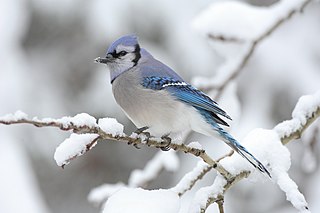
Corvidae is a cosmopolitan family of oscine passerine birds that contains the crows, ravens, rooks, jackdaws, jays, magpies, treepies, choughs, and nutcrackers. In colloquial English, they are known as the crow family, or, in jargon, corvids. Currently 133 species are included in this family. The genus Corvus, including the jackdaws, crows, rooks, and ravens, makes up over a third of the entire family. Corvids are the largest passerines.

The blue jay is a passerine bird in the family Corvidae, native to eastern North America. It lives in most of the eastern and central United States; some eastern populations may be migratory. Resident populations are also in Newfoundland, Canada; breeding populations are found across southern Canada. It breeds in both deciduous and coniferous forests, and is common in residential areas. Its coloration is predominantly blue, with a white chest and underparts, and a blue crest; it has a black, U-shaped collar around its neck and a black border behind the crest. Males and females are similar in size and plumage, and plumage does not vary throughout the year. Four subspecies have been recognized.

The acorn woodpecker is a medium-sized woodpecker, 21 cm (8.3 in) long, with an average weight of 85 g (3.0 oz).
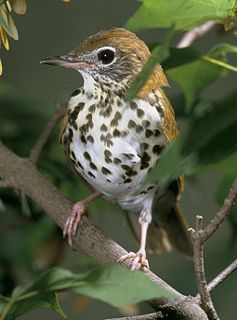
The wood thrush is a North American passerine bird. It is closely related to other thrushes such as the American robin and is widely distributed across North America, wintering in Central America and southern Mexico. The wood thrush is the official bird of the District of Columbia.

The Mexican jay formerly known as the gray-breasted jay, is a New World jay native to the Sierra Madre Oriental, Sierra Madre Occidental, and Central Plateau of Mexico and parts of the southwestern United States. In May 2011, the American Ornithologists' Union voted to split the Mexican jay into two species, one retaining the common name Mexican jay and one called the Transvolcanic jay. The Mexican jay is a medium-sized jay with blue upper parts and pale gray underparts. It resembles the Woodhouse's scrub-jay, but has an unstreaked throat and breast. It feeds largely on acorns and pine nuts, but includes many other plant and animal foods in its diet. It has a cooperative breeding system where the parents are assisted by other birds to raise their young. This is a common species with a wide range and the International Union for Conservation of Nature has rated its conservation status as being of "least concern".
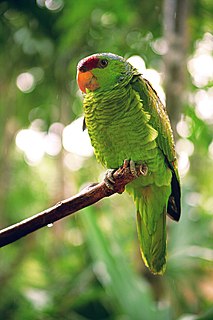
The lilac-crowned amazon is a parrot endemic to the Pacific slopes of Mexico. Also known as Finsch's amazon, it is characterized by green plumage, a maroon forehead, and violet-blue crown and neck.

The rainbow pitta is a small passerine bird in the pitta family, Pittidae, endemic to northern Australia, most closely related to the superb pitta of Manus Island. It has a velvet black head with chestnut stripes above the eyes, olive green upper parts, black underparts, a bright red belly and an olive green tail. An Australian endemic, it lives in the monsoon forests and in some drier eucalypt forests.

The purplish-backed jay is a bird of the crow family Corvidae, with purple feathers on its back, wings and tail, and black feathers elsewhere. It is endemic to northwestern Mexico where its habitat is mainly dry deciduous forest. The International Union for Conservation of Nature has assessed it as being a "species of least concern".
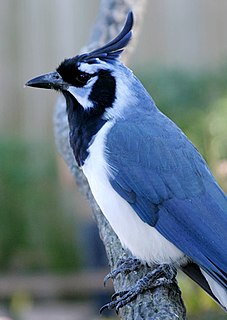
The black-throated magpie-jay is a strikingly long-tailed magpie-jay of northwestern Mexico.
The tawny deer mouse or marsh mouse is a species of rodent in the family Cricetidae. It is found only in Mexico.

The short-crested coquette is a Critically Endangered species of hummingbird in the "coquettes", tribe Lesbiini of subfamily Lesbiinae. It is endemic to a small area of Mexico.
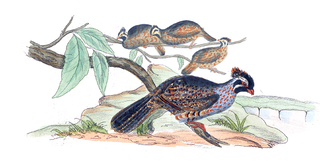
The long-tailed wood partridge is a bird species in the family Odontophoridae, the New World quail. It is found only in Mexico.

The bushy-crested jay is a species of bird in the family Corvidae. It is found in Central America, where its natural habitats are subtropical or tropical moist montane forests and heavily degraded former forest. There are two subspecies, C. m. melanocyaneus which is found in Guatemala and southern El Salvador, and C. m. chavezi from Honduras and northeastern Nicaragua.

The Yucatan jay is a species of bird in the family Corvidae, the crows and their allies. It is native to the Yucatán Peninsula where its habitats are subtropical or tropical dry forest, plantations and cleared areas at altitudes up to 250 m (820 ft). Adults are about 30 cm (12 in) long, black, with blue wings, mantle, and tail, black bills, yellow eye rings and legs. Immature birds have yellow bills. This is a common species of jay with a wide range and the International Union for Conservation of Nature has rated its conservation status as being of "least concern".

The silvery-throated jay is a species of bird in the family Corvidae. It is found in the Talamancan montane forests of Costa Rica and western Panama. The IUCN has rated its conservation status as being of "least concern".

The turquoise jay is a species of bird in the family Corvidae.

The orange-breasted bunting is a species of passerine bird in the family Cardinalidae. It is endemic to Mexico, where its natural habitats are subtropical or tropical dry forests and subtropical or tropical dry shrubland. With its wide range and large total population, the International Union for Conservation of Nature considers it as being of "least concern".
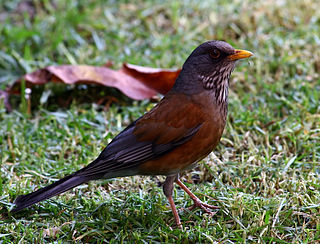
The rufous-backed thrush is a songbird of the thrush family. It is endemic to the Pacific slope of Mexico. It is also known as the rufous-backed robin.
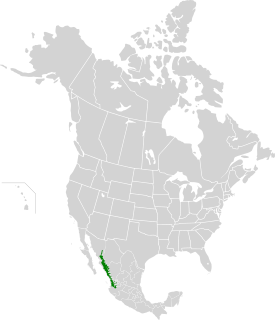
The Sinaloan dry forests is a tropical dry broadleaf forest ecoregion in western Mexico. It is the northernmost ecoregion of the Neotropical realm.

The Jalisco dry forests is a tropical dry broadleaf forest ecoregion in southwestern Mexico.




















